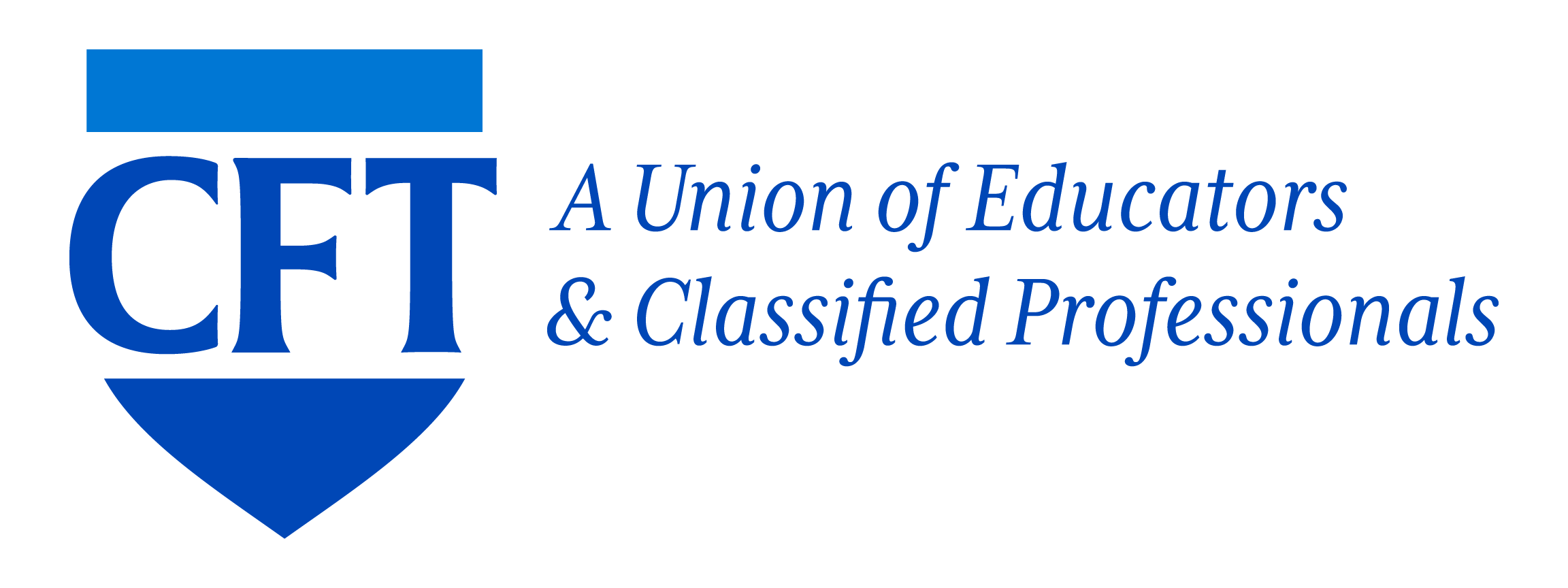Since the passage of the CFT resolution to Develop a strategic plan to end the two-tier system in the community colleges in March of 2022, the One-Faculty Taskforce has spent many hours of discussion and planning to establish both a notion of what a One-Faculty Model should ultimately look like and making big steps towards educating, promoting, and achieving it.
The One-Faculty vision, as detailed here, is essentially a community college faculty system which no longer divides faculty into the categories of “part-time” and “full-time” or non-tenured and tenured, but looks to the idea that regardless of whether one works at less than 100% percent of a full-time equivalent load that:
All faculty have equal job responsibilities including college service, professional development, and ancillary work proportionate to % of load taught;
All faculty, after a locally-negotiated probationary period with successful evaluations, would achieve permanent status with the opportunity to increase or reduce their teaching load without loss of status;
All faculty would be on the same salary schedule and paid proportionate to their load;
All faculty would be entitled to the same benefits, including retirement.
The first actions of the task force were three-fold:
First, to educate faculty outside the task force through presentations such as the one given at the 2025 CFT Convention.
Second, to attack the issue of part-time faculty due process head on through legislation with the sponsoring of AB1028.
Third, to establish subcommittees to address the larger and more complex task of creating an environment for a strategic plan to be enacted, focused on:
Expanding Awareness and Communicating the Message
Local Union Actions
Coalition Building with Other Unions and Faculty Advocacy Groups
Bargaining
Legislation
Each subcommittee has met several times, with work moving forward in various degrees.
In terms of awareness and communications, CFT took a tremendous step forward with an inaugural CFT Statewide One-Faculty Workshop held online on July 1st with over 100 members, both part and full-time faculty from over 19 different locals.
“We wanted to give CFT members a simple rundown of what the One Faculty campaign is all about. It was a chance to both explain the basics, update them on our progress so far, get people excited to be part of it, and listen to their questions and concerns,” said Jessica Thompson, a One-Faculty Taskforce member and chair of the San Diego-Grossmont Cuyamaca/Faculty Guild Adjunct Faculty Committee, who led the central workshop presentation.
After a presentation of about 30 minutes which explained the rationale and basics of the one-tier model and its inspiration (the “Vancouver Model” from Vancouver City College in British Columbia), the workshop attendees then went into a series of 15 breakout sessions, each assigned to discuss different questions, such as, “Why is unifying full-time and part-time faculty essential to the campaign?” or “How might achieving equity for faculty impact student outcomes, such as retention, engagement, or equity gaps?”
In response to the first question, one group said, “Being unified can work against the administration playing the groups against each other. It helps control the narrative.” As to the second, another group noted how this could lead to “the retention of present adjuncts allowing for long term engagement with students and a capacity for greater participation in campus activities.”
Tougher questions were asked in the breakout sessions as well, such as “What arguments have you heard against moving toward a one-tier system? How can the campaign respectfully engage those views?” And “Some faculty or administrators might argue that equity initiatives are too expensive or unrealistic. How would you respond to that?”
One attendee, Naveem Kinal, member of Adjunct Faculty United, representing the North Orange Community College, echoed the concerns of the last question, but at the same expressed an eagerness to promote the model, and engage in advocacy for the plan. In fact, he expressed a guarded enthusiasm for the plan and noted the need for “finding allies across the state.”
The one-tier explorations are happening elsewhere as other organizations, such as the ASCCC, have passed resolutions or statements of support of a One-Faculty/One-Tier Model, such as FACCC and CCCI, or they have formed task forces themselves, such as CTA’s Community College Association, or CCA.
One notable aspect of the event was the number of full-time faculty in attendance, some of whom had never heard of the One-Faculty Model before but were curious about it. And they walked away interested. This was not lost on One-Faculty Taskforce Tri-Chair Linda Sneed who noted that something she learned from the event is the “need to be widening our discussions and insights, and to communicate to full-time faculty that the One-Faculty Model is not a threat to their job security or duties.”
Both Thompson and Sneed saw the event as a success, reflecting the consensus of those involved with the planning. As for why, Thompson noted that, “The workshop went really well because we put in a lot of preparation ahead of time. We wanted to make sure everything flowed smoothly and that members walked away with clarity and inspiration, and also with some materials they could bring back to their locals.”
And in fact, the goal of the event was to create the opportunity for further discussions in future workshops at the state level, and at the local level.
Post workshop, the taskforce has come together to collect and identify the internal goals and achievements established by each subcommittee, which will in turn be used to put forth a tentative set of phases for work on the One-Faculty Model.
First is a plan to survey local leaders about their knowledge of the One-Faculty Plan in their locals, and second is the creation of a One-Faculty Toolkit for local groups to draw knowledge from. To make the toolkit more actionable, the CFT One-Faculty Taskforce is also working with its locals on a One-Faculty Week, planned for October 27th-31st. They hope that not simply adjunct, but full-time faculty will join the various One-Faculty Week planning committees that are currently coming together.
